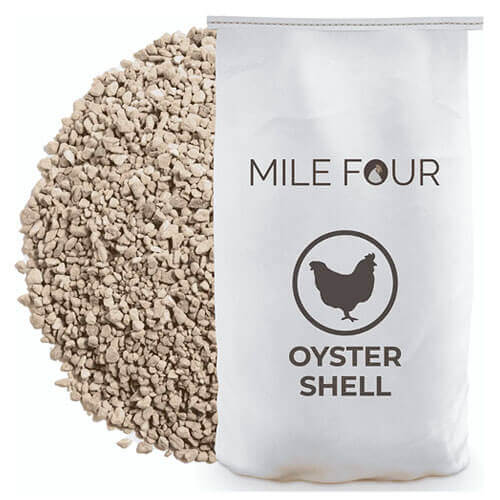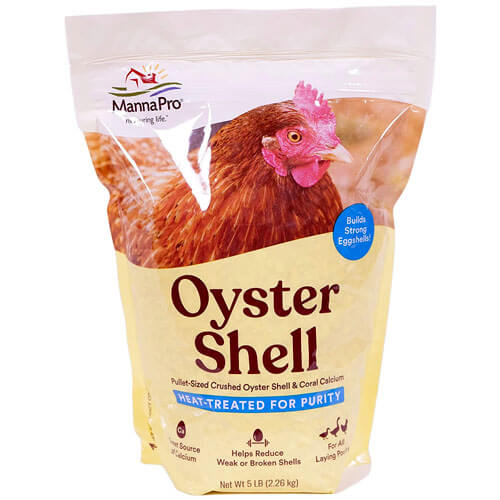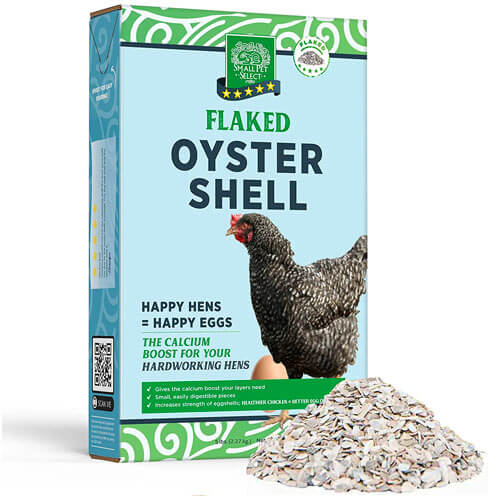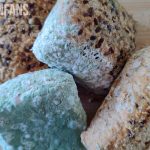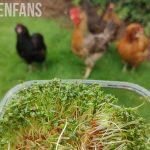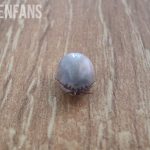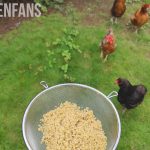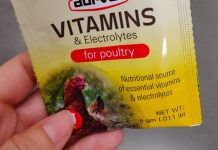Calcium for Chickens: Best Supplements, Optimal Values & Calcium Sources
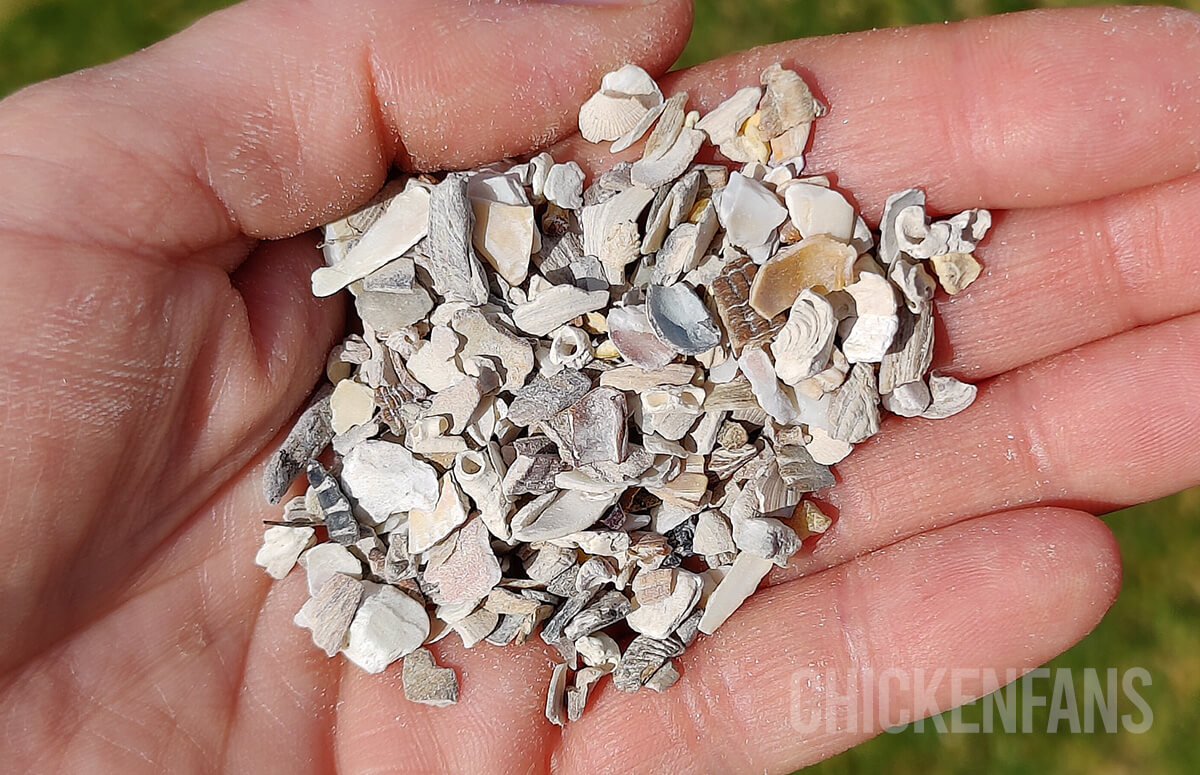

If you have chickens, you know the importance of calcium, especially for laying hens. Adequate calcium intake results in more eggs and stronger eggshells. However, there is more to calcium than egg production and eggshell quality.
We will go in-depth on why chickens need calcium and its effects on the body. We will discuss the best calcium sources for chickens and tackle the risks of calcium deficits and calcium surplus.
Here are some key takeaways:
- Hens need 4-5 g of calcium daily when laying
- Chickens need vitamin D to use the calcium
- Too much calcium is dangerous
- Provide calcium in a separate container
- Oyster Shells & Limestone are proper calcium sources
- Add more coarse-grained calcium when egg-laying progresses
If you are in a hurry for supplements, here are some top picks:
- Provide supplemental coarse-grained calcium to laying hens in a separate container a few weeks before they start laying (around week 18 – 20).
- Laying hens older than 34 weeks should get more than 50% coarse-grained calcium supplements up until 70% at the end of the lay.
Now, let’s first see how much calcium laying hens need. It’s a lot!
How Much Calcium Do Chickens Need?
Laying hens require 4-5g of calcium daily when they are laying.
The exact amount of necessary calcium depends on age, sex, breed, and the laying cycle phase:
| Type | Age | Optimal Calcium Levels |
|---|---|---|
| Starter hatchlings | 0-4 weeks | 1 g/day |
| Chicks | 5-9 weeks | 0.95 g/day |
| Grower | 10-16 weeks | 0.9 g/day |
| Pre-lay Pullets | week 16/17 until the first egg | 2.2 – 2.5 g/day |
| Adult Laying Hens | 26 – 45 weeks | 3.7 – 4.0 g/day |
| Adult Laying Hens – Post peak | 45+ weeks | 3.7 – 4.7 g/day |
| Meat Chickens (broilers) | > 16 weeks | 1.0 – 1.5 g/day |
| Adult Roosters | > 16 weeks | 1.0 g/day |
This is double the amount we believed hens needed (at the beginning of the 20th century, the general consensus was that laying hens should be given 2.27 mg of calcium per day).
Pullets and roosters have lower calcium needs than laying hens as they do not produce eggs.
Let’s clarify why chickens need calcium, as calcium plays several crucial roles in the chicken’s body.
Why Is Calcium Important For Chickens?
Calcium is essential for chickens as it’s vital for egg production, controls heart rate and blood clotting, promotes a healthy nervous system, supports growth and development, boosts bone strength, activates digestive enzymes, and regulates the body’s pH. Calcium also metabolizes other minerals, such as phosphorus.
Calcium affects hormone production hence influencing reproduction (critical for egg production). Plus, calcium controls muscle spasms, which helps with the egg-laying process and is vital for the formation of eggshells.
Calcium & Egg Production
Producing an egg every 24 to 48 hours (the average production rate for most laying breeds) requires ample amounts of calcium. This is because calcium is the main component of the eggshell.
But where does all that calcium come from? Well, things are simple – for chickens, there are two sources of calcium. One source is their diet, and the other one is… their bones.
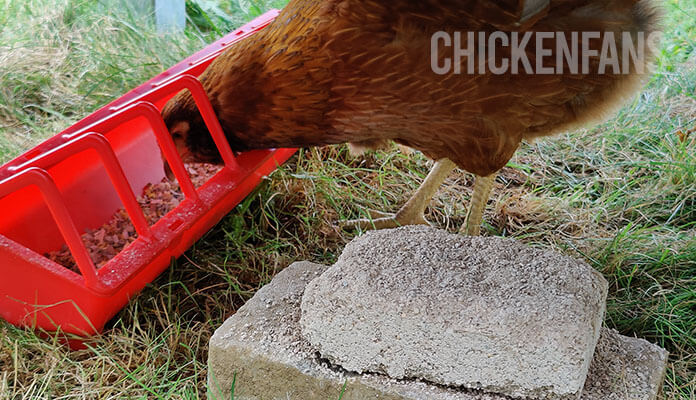
When the hen does not receive enough calcium through the diet, it will pull out calcium from its bones. If this is an isolated case, there is no harm.
However, if the diet is consistently deficient in calcium, the chicken will keep using calcium from its bones. When the calcium levels in the bones reach a certain low level, egg production decreases and ceases. Calcium loss also leads to health issues, such as osteoporosis and increased risk of injuries.
Supplementing Calcium Alone Is Not Enough for Chickens
Calcium is vital for health and egg production. However, on its own, calcium is not enough. The utilization of calcium depends on two other nutrients – phosphorus and vitamin D.
Phosphorus is an essential mineral that hens need for strong bones and various body functions. It is also vital for metabolizing calcium. Calcium and phosphorus bind, and when one of them is deficient, the other one cannot be used properly.
The good news is that, in theory, it is almost impossible for chickens to be phosphorus deficient. Phosphorus is abundantly present in grains, which are the foundation of every chicken feed.
The other nutrient, vitamin D, is a fat-soluble vitamin that affects calcium and phosphorus metabolism. To be more accurate, vitamin D regulates the amount of calcium released from the bones into the bloodstream.
What Size of Calcium Supplement Do Chickens Need?
The size of necessary calcium depends on age, sex, breed, and the laying cycle phase. Fine calcium particles are 0-2mm, and coarse-grained calcium particles are 2-4mm.
| Type | Age | Fine Calcium | Coarse Calcium |
|---|---|---|---|
| Starter hatchlings | 0-4 weeks | 100% | 0% |
| Chicks | 5-9 weeks | 100% | 0% |
| Grower | 10-16 weeks | 70% | 30% |
| Pre-lay Pullets | week 16/17 until the first egg | 50% | 50% |
| Laying Hens – Peak | 26 – 33 weeks | 50% | 50% |
| Laying Hens – Post Peak | 34 – 48 weeks | 40% | 60% |
| Laying Hens – End of lay | 48+ weeks | 30% | 70% |
| Meat Chickens (broilers) | > 16 weeks | 50% | 50% |
| Adult Roosters | > 16 weeks | 50% | 50% |
It’s a good practice to add larger particles of calcium, such as limestone, to the diet of laying hens before they start laying. This builds up the calcium reservoirs in their medullary bones. Introducing larger calcium particles earlier eases the transition to high-calcium diets when the egg-laying is at its maximum.
After the lay starts, the size of particles should gradually increase until the proportion is around 75% of the total calcium at the end of the lay.
What Are Natural Calcium Sources for Chickens?
The best natural calcium sources for chicken are:
- Oyster Shell: Oyster shell is the most commonly used calcium supplement. It contains 36-38% calcium and is absorbable. The shells are grounded, and the particle size is an important feature – they should be small enough to be easily eaten yet large enough to remain in the digestive tract for some time (the more time they spend there, the more calcium the body absorbs). Ideally, the particles should be the size of a pea. Oyster shells and marine shells are excellent soluble calcium sources with low microbiological contamination.
- Limestone: Another excellent source of calcium is limestone (calcium carbonate). It is less absorbable than oyster shells (it travels through the digestive system quickly) but also more affordable. Dark limestone is generally older and contains more impurities (such as magnesium).
- Diatomaceous Earth: Diatomaceous earth or white earth is made of fossilized algae and is rich in calcium. It is also used as a natural dewormer.
- Bone Meal: Bone meal is made by grounding the bones of slaughtered animals and is a rich source of calcium. There is also an alternative – a fish meal. Bear in mind that the eggs may have a distinct fishy smell when using a fish meal.
Stay away from dolomite limestone and other bad calcium sources.
What Are Bad Calcium Sources for Chickens?
Now that we covered the best natural calcium sources for chickens let’s say a word or two about the worst sources. Knowing what not to give can be just as important.
- Milk: We know that milk is packed with calcium. Therefore, it is only logical to wonder whether giving milk to chickens is alright. The answer is a resounding no. Milk is not part of the chicken’s natural diet and can trigger severe diarrhea.
- Raw Eggshells: Raw eggshells are a bad idea for two reasons. First, they can be contaminated with Salmonella and result in infections. Second, feeding your chicken raw eggshells might support egg-eating behavior (a bad and definitely unwanted habit).
- Dolomite Limestone: Another bad source of calcium is dolomite limestone. Unlike limestone (calcium carbonate), dolomite (calcium magnesium carbonate) contains up to 10% magnesium. Magnesium competes with calcium and interferes with its utilization.
- Agriculture limestone: don’t feed limestone to chickens that’s meant to be used as a soil fertilizer. Garden limestone has inappropriate calcium concentrations and solubility for consumption.
Risks Of Calcium Deficiency
As we already mentioned, when the diet lacks calcium, the chicken uses its reserves. The effect is detrimental and results in fragile eggshells, soft-shelled eggs, decreased egg production, and dystocia or egg retention.
The calcium drop in the bones increases the risk of osteoporosis and injury (bone fractures) and may cause bone and joint deformities. Then, the hens develop lameness and weakness and experience loss of coordination.
Risks Of Excess Calcium
Issues caused by excess amounts of calcium are far rarer than issues caused by calcium deficits. However, calcium surplus is still possible. The scientific name for extra calcium in the body is hypercalcemia.
Hypercalcemia is a dangerous condition. When there is extra calcium in the body, the kidneys try to eliminate the surplus. However, while being eliminated, calcium deposits and calcifies the kidneys (causing potentially life-threatening damage). It can also result in liver damage.
Hens consuming diets too high in calcium produce bumpy eggs (the eggshell is uneven due to the heavy calcium deposits).
When to Add Extra Calcium to a Chicken’s Diet
If your birds slow down on laying or have abnormal eggs with fragile shells but are otherwise healthy, they might suffer from calcium deficiencies. If you are feeding All Flock mix and the laying hens don’t have access to extra calcium, chances are high that they don’t have enough calcium in their body to be productive.
However, there are many other reasons why egg laying can be impacted where the hens don’t need extra calcium:
- It’s very common for young birds to start with smaller, thin-shelled eggs because of their immature shell glands
- the birds might suffer from Infectious Bronchitis, a common viral disease that’s known to impact the eggshells
- the chickens can be suffering from stress; that’s common when they don’t have enough space, there is bullying going on, or you have an aggressive rooster
- they might be suffering from heat stress and it’s just too warm for them to lay
- they might suffer from Vitamin D deficiencies due to lack of sunlight or improper diet
- sometimes they are just getting older, and it’s part of nature
A recurring discussion is what to do to support chickens that are molting. Chickens need large amounts of proteins to produce their new feathers, but they also need calcium. Even when they don’t lay eggs during the molt, it’s a good idea to provide them with an extra container of calcium to give them a free choice.
Commercial Calcium Supplements
There are many calcium supplements on the market. Ideally, you want a coarse-grained calcium mix, which contains more than 35% calcium and is absorbable.
All supplements are a mix of fine calcium and coarse-grained particles. Most supplements are advertised as if they are pure oyster shells, but in reality, they contain few to no oyster shells.
For laying hens passing their peak in the laying period, you want sufficient coarse-grained particles the size of a pea. The more time the calcium particles spend in the digestive tract, the more calcium the chicken’s body can absorb.
Mile Four Organic Oyster Shell
Mile Four provides organic chicken feed sourced 100% from U.S. family farms. Although their calcium supplement is advertised as Oyster Shell (it’s the only label printed on the package), all particles are pure limestone. They guarantee 33-38% calcium content.
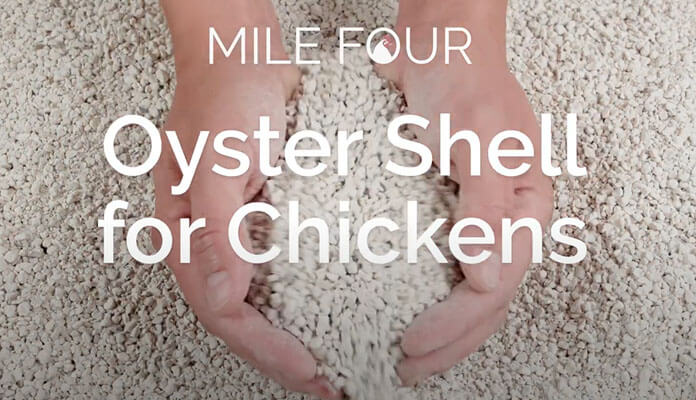
The particles are a mix of fine and coarse-grained crushed limestone.
| Calcium Particle Size | Percentage |
|---|---|
| < 1mm (ultra-fine calcium carbonate) | 3% |
| 1-2 mm (fine calcium carbonate) | 4.5% |
| 2-4 mm (coarse limestone) | 79.5 % |
| > 4 mm | 13 % |
Since the mix is more than 70% coarse-grained particles, it’s ideal for laying hens. Mile Four recommends adding it to separate feeders for laying hens that are 20+ weeks old.
This is in line with our recommendation to add coarse-grained calcium supplements to pullets in their pre-laying period. Recall that layers need more and more coarse-grained calcium the further they get into the laying period.
Mile Four Oyster Shell is a pure calcium source. It only contains 0.01% phosphorus and no vitamin D, so these must be provided via regular food. Phosphorus is abundantly present in grains.
If you look at the fine print, it’s presented as an oyster shell alternative. At least they are honest about the package containing no oyster shells. Limestone is a perfect affordable calcium source alternative that’s also used in the poultry industry.
Manna Pro Oyster Shell
Manna Pro also sells Oyster Shell supplements for laying hens. They guarantee 33-38% calcium content. The product is a mix of pure Oyster Shell and Coral Calcium. The label does not specify how much of the package is actually crushed oyster shells, so we expect 90% is coral calcium or ground limestone.
Particle Size
We found about 80% of the calcium particles are (very) hard 2-4 mm rocks with very few shells. These coarse-grained calcium particles are ideal for large laying hens.
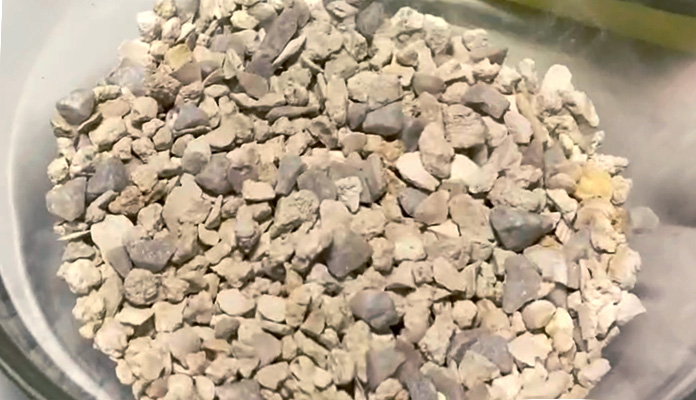
Manna Pro advises providing the calcium supplements in a separate container to pullets starting at 18 weeks and to continue feeding across the laying period. That’s again in line with our recommendation to add coarse-grained calcium supplements to pullets starting from their pre-laying period.
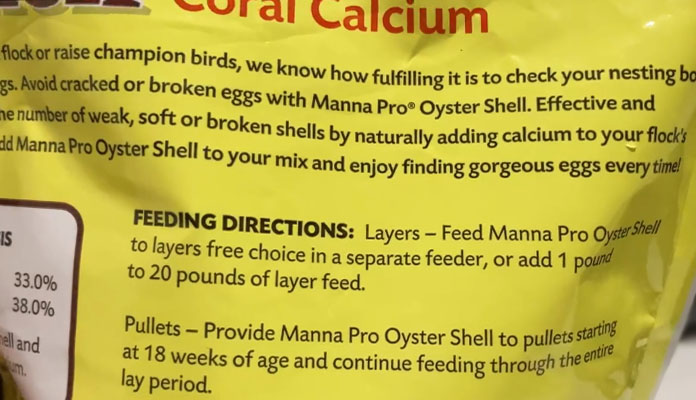
Coral Calcium for Chickens
Coral calcium comes from coral sand deposits, which were once part of a coral reef. The coral remnants are collected from the coast or shallow water and initially contain dirt and impurities. After filtering, most of the coral calcium is calcium carbonate, but there are also traces of magnesium and other minerals.
Magnesium competes with calcium and interferes with its utilization. Researchers have also found significant amounts of lead in coral calcium in the past. We give Manna Pro the benefit of the doubt and expect them to use qualified raw material suppliers for dietary supplements.
The coral calcium is, in fact, limestone, which coral organisms manufacture as a protective shell. Since coral reefs are protected, coral calcium is made by collecting sand and crushing limestone without living organisms.
There are many health claims about coral calcium, but coral calcium is not in itself superior or inferior to other forms of calcium.
Small Pet Select – Flaked Oyster Shell
Small Pet Select sells a flaked oyster and seashell mix. These are real shell flakes compared to other vendors that put oyster shells on the label but actually sell crushed limestone. That’s why they can guarantee 37-40% calcium content.
In the course of 2022, there has been a shift towards more seashells and fewer oyster shells.
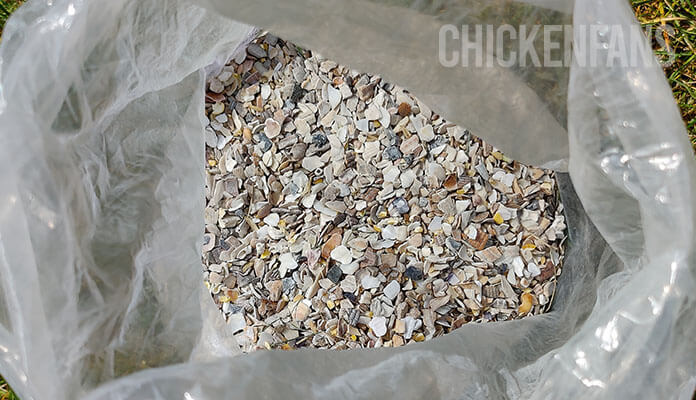
These oyster shells and marine shells are excellent soluble calcium sources that have low microbiological contamination.
There is a mixture of particle sizes. All shells are flakes. Some flakes are big, and since they are shells, they can be quite sharp. They seem much more consumable to the average hen than the Manna Pro rocks. But if you have bantams, they might not eat the bigger flakes.
Small Pet Select recommends providing the shells in a separate container to laying hens at about 20 weeks. This is the same as Mile Four and is in line with our recommendation to add coarse-grained calcium supplements to pullets before they start laying eggs.
Conclusion
Calcium is a vital mineral for chickens. First, it is critical for health and normal body functioning, and second, it enables egg production and eggshell formation.
While calcium needs vary among breeds, sexes, and age groups, it is vital to provide laying hens with 4-5 mg of calcium per day. The diet must also be rich in phosphorus and vitamin D to ensure proper calcium use.
Lastly, remember that both calcium deficiency and excess calcium are harmful. Consult a vet if you are unsure how much calcium your chickens need for optimum health and performance.

Dr. I. Crnec is a licensed veterinarian with several years of experience. She has published work on the effect of vitamin supplementation, egg-laying performances of chickens under heat-stress conditions and the effects of calcium supplementation on eggshell strength.
Related Articles
- Rooster Booster Poultry Cell: a broad spectrum vitamin, mineral, and amino acid supplement to boost chicken health when under stress
- Rooster Booster Vitamins & Electrolytes with Lactobacillus: a vitamin and electrolyte supplement that also contains probiotics
- Vitamin B12 for Chickens: Vitamin B12 is an essential vitamin for chickens that plays a core role in many vital body processes.
- Probiotics for Chickens: probiotics are natural supplements with live microorganisms found in the chicken’s digestive system. They promote a healthy gut, boost the immune system, egg laying, and prevent viral and bacterial diseases.
- Vitamin K for Chickens: vitamin K is a group of 3 chemicals essential for blood clotting, biosynthesis of proteins, bone composition, and embryo development in chickens and poultry.
- Vitamin D for Chickens: Vitamin D is essential for chickens, especially laying hens and chicks. It supports skeleton development and proper immune functioning.
